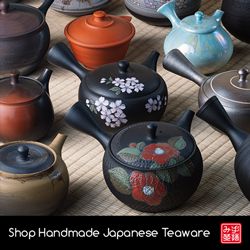Genmaicha (玄米茶, brown rice tea) is  essentially a mix of green tea and roasted rice.
essentially a mix of green tea and roasted rice.
This blend balances the astringency of green tea with the nutty flavor of the roasted rice.
The Japanese consider genmaicha as a type of Japanese green tea and not an ordinary blend, perhaps because they have been enjoying it for quite a long time.
How is genmaicha made?
Genmaicha is traditionally made with bancha. However, nowadays the market offers a lot of options, such as sencha genmaicha (煎茶玄米茶, made with sencha), houji genmaicha (ほうじ玄米茶, made with houjicha) and gyokuro genmaicha (玉露玄米茶, made with gyokuro).
Sometimes matcha is also added to genmaicha, and its called matcha iri genmaicha (抹茶入玄米茶). Genmaicha with added matcha is easy to recognize because the roasted rice looks green!
The roasted rice, called genmai (玄米), is generally mixed with green tea in a proportion of 1 : 1, although this ratio can change depending on the manufacturer.
Genmai is also the word for “brown rice” in Japanese, but most of the roasted rice is actually made with white rice. Because both the roasted rice of genmaicha and brown rice use the same word, it’s a bit confusing.
Why use white rice instead of brown rice? Apparently, brown rice is not as fragrant when roasted and it becomes much darker than roasted white rice.
By the way, brown rice is produced by taking off the husk of the rice, so that normal white rice is just milled brown rice.
The traditional way of making genmaicha is by using mochi rice (もち米, mochigome). Genmaicha with 100% mochi rice has the highest quality.
Genmaicha is also made with common Japanese rice, uruchimai (うるち米). Sometimes, a blend of both types of rice is used.
The process to make the roasted rice has five simple steps:
- The rice is soaked in water for some time, so that it can be easily steamed.
- The rice is steamed.
- Drying process begins. There is more than one way to do this, one of which is by using hot air.
- Once the rice is dried, it is roasted.
- The roasted rice is then cooled.
I also wrote a post on how to make your own roasted rice for genmaicha, in case you want to give it a try!
What about the popcorn in genmaicha?
What looks like popcorn is actually popped rice. It used to pop frequently during the traditional roasting process.
Now with machinery having better temperature control, the roasted rice doesn’t pop as much, so it’s mainly added for a better look. Genmaicha is often made without it and the quality is the same.
History of genmaicha
Genmaicha doesn’t have an established history. One explanation about the origin of genmaicha states that it started when a man in Kyoto dropped his kagami mochi (a mochi rice cake used as decoration for the Japanese New Year) and didn’t want all of it to go to waste, so he took some small pieces and drank them with green tea.
Another possible origin for genmaicha may have been Korea, since Koreans have been drinking a tisane of roasted brown rice for a long time.
Eitherway, the idea of adding roasted rice became popular with the common people since it lowered the cost of tea. That is why bancha (which is cheaper than sencha) is traditionally used for making genmaicha.
How to brew genmaicha
Genmaicha is considered to be a low  grade tea, along with bancha and houjicha.
grade tea, along with bancha and houjicha.
Hence the brewing method is to use high temperature when brewing (as opposed to high grade tea like gyokuro).
Use 3 to 4 grams of genmaicha per cup and add to your kyusu (Japanese tea pot).
The following video shows a type of kyusu called dobin (土瓶). Pour 120ml of boiling water per cup in the dobin, and let brew for 30 seconds.
Now pour the genmaicha into each cup. Don’t fill the first cup all at once, alternate from cup to cup as shown in the video.
I encourage you to try genmaicha, it’s my personal favorite!





August 26, 2016
Love this tea
What are the health benefits
August 26, 2016
Hi Doreen
Unfortunately, the health benefits are only half of what pure green tea would offer.
If your main interest are the health benefits, I suggest that you drink matcha.
August 26, 2016
Is the Genmaicha green tea with roasted brown good for fatty liver
August 26, 2016
Some studies show that green tea catechins may have hematoprotective effects. Note that protection is not the same thing as curing.
There are also studies that show that too many catechins can cause liver damage. This often happens in the form of green tea supplements for people that want to lose weight.
Again, if you want more catechins, genmaicha is a poor choice because it’s 50% rice.
Source: Scientific Evidence for the Health Benefits of Green Tea, Japan Tea Central Public Interest Incorporated Association, 2015
May 20, 2019
Thank you for your most informative article. I drink one cup a night, a special treat! What are your most recommended brands of commercial genmai cha?
May 21, 2019
Hi Marjamagda
Nowadays I drink genmaicha about once every day, my wife likes it very much as well.
It’s hard to give you a recommendation without knowing where you live, but one I like is the genmaicha from Obubu Tea, which is made with mochi rice.